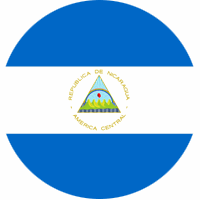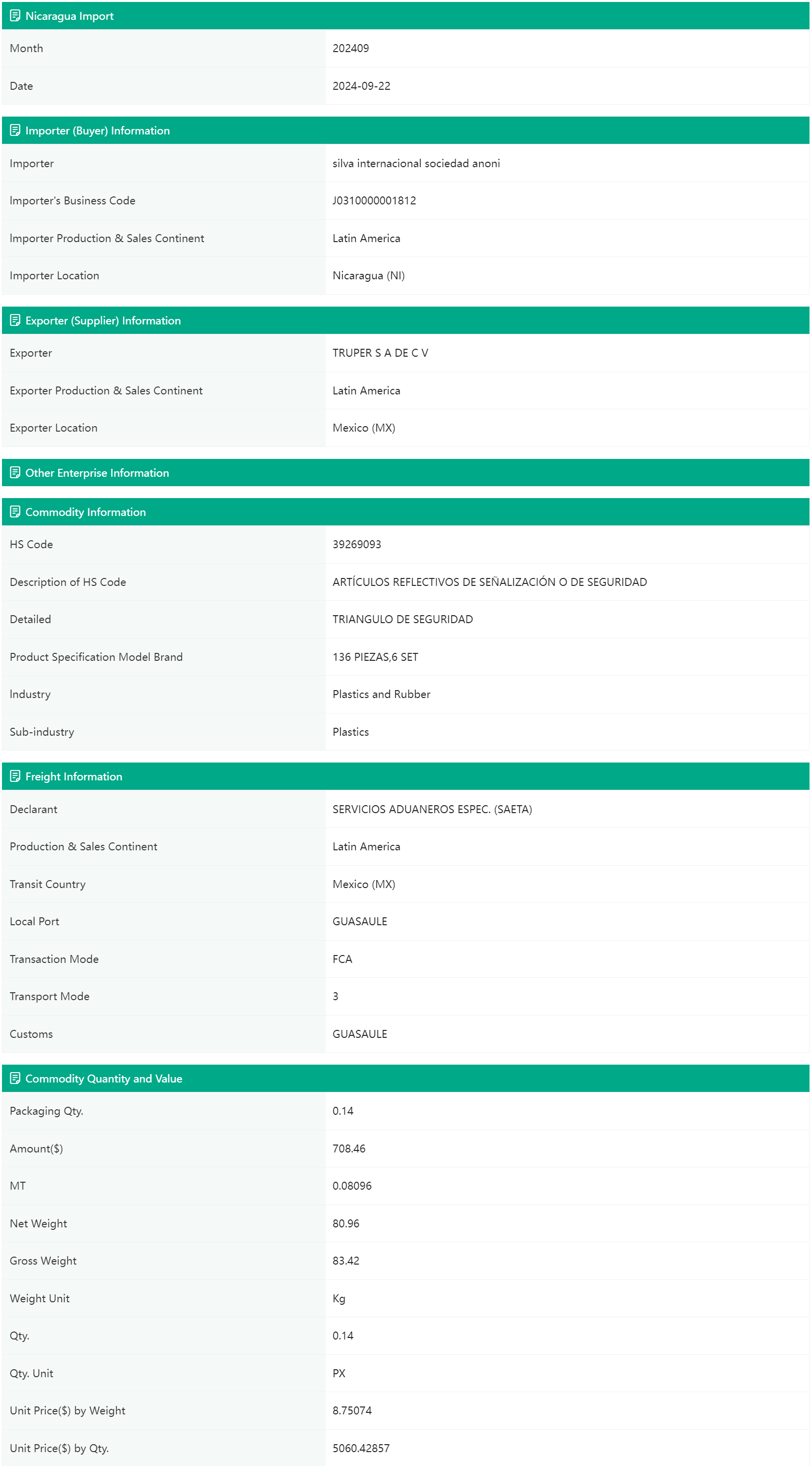Please Sign in to view recently saved searches.
Nicaragua is located in the central part of Central America. It borders the Caribbean Sea to the east and the Pacific Ocean to the west. It is bordered by Costa Rica and Honduras to the south and north respectively. It is the largest country in Central America. Its economic situation is only better than that of Haiti in Latin America.
Nicaragua is located in the center of the American continent and is adjacent to two oceans. It has obvious location and radiation advantages. It is a member of the World Trade Organization (WTO) and Central American Integration (SICA). It has trade relations with more than 50 countries and regions. It has signed free trade agreements with other Central American countries, Mexico, the Dominican Republic, the United States, Chile, the European Union, South Korea, etc.; it has signed preferential tariff agreements with Canada, Norway, Japan, Russia, Switzerland, Colombia, Ecuador, etc.; it has signed bilateral investment promotion and protection agreements with Spain, Denmark, Germany, the United Kingdom, Chile, France, Argentina, Switzerland, Sweden, South Korea, the Netherlands, the Czech Republic, Italy and Russia. In July 2022, China and Nicaragua signed the "early harvest" arrangement of a free trade agreement and started full-scale free trade agreement negotiations.
The official language of Nicaragua is Spanish. Sumo, Miskito and English are also commonly used on the Atlantic coast.
【Customs】
When Nicaraguans meet, they usually greet each other with a handshake. Those with close relationships hug each other and pat each other on the back. Women often give a gentle hug and kiss each other on the cheek. At small banquets, the host is always happy to introduce the guests to every guest present and exchange brief greetings at the same time. The Nicaraguan people are very disgusted with foreigners who are arrogant and domineering. They are neither harsh nor blindly obedient to anyone. Therefore, as a businessman, you should negotiate relevant matters with them on an equal footing to win friendship and trust. After reaching an agreement and signing a contract, they can generally fulfill the contract seriously. Before doing business in Nicaragua and choosing customers, you should conduct preliminary research, including credit status and business scope.
【Agriculture】
Agriculture and animal husbandry in Nicaragua are the foundation of the national economy and an important sector for earning foreign exchange through exports. In 2021, the main agricultural export products of Nicaragua were coffee ($508 million) and peanuts ($102 million).
As of June 2024, the cumulative export value of agriculture ($551.7 million) decreased by 18.5% year-on-year. This is the result of a decrease in coffee exports (-$117.9 million; -25.6%); beans (-$21.5 million; -23.9%), live cattle (-$0.6 million; -30.1%); and sesame (-$0.4 million; -21.8%), mainly due to the decline in export volumes of these products. In contrast, exports of agricultural products such as peanuts (+$6.3 million; 9.1%), tobacco (+$0.3 million; 6.4%) and bananas (+$0.2 million; 12.0%) have increased.
【Forestry】
Nicaragua has a forest area of 2.6 million hectares, of which coniferous forests account for 450,000 hectares and are mostly distributed in the northwest. Broad-leaved forests account for 2.15 million hectares and are mostly distributed along the Atlantic coast. The main tree species are mahogany, fir and pine. The tropical rainforest area along the eastern Atlantic coast is rich in forest resources and is an important timber production area and logging area. The annual timber output is about 80 million cubic meters, supplying domestic and foreign markets. There are as many as 65 types of timber exports, including mahogany, teak, red sandalwood, rosewood, cypress, pine, etc. Among them, mahogany, teak and rosewood are the most popular.
【Animal Husbandry】
Animal husbandry occupies an important position in Nicaragua's economy. In 2021, Nicaragua's live livestock exports amounted to $16.8 million, and beef exports reached $726 million, an increase of 33.9% year-on-year.
【Fishery】
There are about 311 species of fish in the Pacific waters of Nicaragua, mainly shrimp, shellfish, sea cucumbers, octopuses and squid. There are 305 species of fish in the Atlantic waters, mainly large fish such as yellowfin tuna and sharks. The main fishery products include shrimp, farmed shrimp, lobster, sea bass, grouper, croaker, yellow croaker, eel, yellowfin tuna, octopus, sea crab, conch, sea cucumber and other fishery products.
The Pacific Gulf of Nicaragua has ideal conditions for shrimp farming. Its shrimp production potential is estimated to reach one-third of the total shrimp production in Central America and Panama. Mainly lobster, prawn and farmed shrimp.
As of June 2024, the cumulative export value of the fishery industry ($70.6 million) increased by 0.9% (+$0.6 million) compared with the same period in 2023, mainly due to the growth in exports of fresh fish (+$5.6 million; 39.3%), due to an increase in quantity (41.8%); lobster (+$2.4 million; 16.4%), due to an increase in quantity (51.0%). In contrast, sea cucumber exports (-34.7%) decreased due to a decrease in exports (-18.1%) and prices (-20.3%), tuna (-21.9%) decreased due to a decrease in prices (-29.8%) due to a decrease in exports (-18.8%), shrimp (-17.6%).
【Mining】
The main minerals in Nicaragua are gold and silver mines. Currently, there are eight major mining areas. It is estimated that Nicaragua has gold reserves of 3.8 million ounces and silver reserves of 4.9 million ounces. There are also other mineral deposits such as gypsum, lime, marble and quartz.
In 2021, Nicaragua's gold export value was $868 million, an increase of 30.5% year-on-year. Non-metallic mineral products are mainly limestone and sand. The main export markets are neighboring El Salvador and Honduras.
As of June 2024, the cumulative export value of the mining industry was $665.3 million, which means an increase of 22.2% ($121.1 million) compared with the same period in 2023, mainly due to the increase in gold exports ($115.5 million; 21.8%) and silver ($5.5 million; 42.3%), due to an increase in average contract prices and export volumes.
【Manufacturing】
Nicaragua has abundant labor force and low wages. The government adopts incentive policies for foreign investment, which are important conditions for the development of the manufacturing industry. The main manufacturing industries include farmed shrimp, food, beverages, non-metallic products, oil refining, chemicals, wood, tobacco and ready-to-wear. Most of the main manufacturing industries are concentrated in processing export zones.
As of June 2024, the cumulative export value of the manufacturing industry ($929.7 million) increased by 0.5% ($4.5 million) year-on-year, due to increased shipments of meat (+$50.5 million; 15.2%) and sugar (+$2.2 million; 1.4%), mainly. These factors were offset by declines in dairy products (-$18.8 million; -14.0%), textiles (-$15.9 million; -86.7%), chemical products (-$15 million; -54.2%) and mainly beverages and rum (-$3.5 million; -10.1%).
【Foreign Trade in the Second Quarter of 2024】
Nicaragua's total export value (goods + free zones) in the second quarter of 2024 totaled $2.0223 billion. Of the total export value, 56.3% is commodity exports ($1.1377 billion), and the rest are free zone commodities ($884.6 million).
The total export value increased by 2.7% year-on-year due to a 4.9% increase in commodity exports, while exports from free zones remained similar to the same period last year. The growth in commodity exports was supported by the export vitality of the mining industry, which increased by 29.8%, followed by manufacturing (+6.7%), mainly due to the contribution of the food industry (+12.8%).
As of June 2024, the cumulative total export value was $3.9466 billion, a decrease of 0.9% year-on-year. This is due to a 2.2% decrease in free zone exports. The main reason for the decline in free zone exports (-$38.4 million) is the reduction in placements of wiring harnesses (-$46.9 million) and processed fishery products (-$24.9 million).
From the perspective of destination markets, the United States remains the main destination, accounting for 36.5% of export value, followed by Canada (11.2%), El Salvador (9.8%), Mexico (5.2%), Costa Rica (4.7%), Belgium (4.7%), Guatemala (2.6%), Honduras (2.5%) and China (1.9%). These markets account for 79.1% of total exports in 2024. It is worth noting that exports to the Canadian market increased by 78.6% year-on-year, while exports to the US market decreased by 14.9%. Compared with the same period in 2023, exports to the Central American market decreased by 9.0%, while exports to other regions of Latin America, Europe and Asia increased.
The total import value (goods + free trade zones) in the second quarter of 2024 totaled $2.6527 billion, an increase of 6.1% year-on-year. This result is the result of an 8.7% increase in commodity imports (general regime), which exceeds the 2.2% decrease in imports under the free zone regime. As of June, the cumulative total import value was $5.191 billion, an increase of 9.0% year-on-year. Among them, commodity imports increased by 12.9%, while imports of free zone commodities decreased by 2.7%. The increase in commodity imports was offset by increased purchases of capital goods (+29.4%), petroleum and derivatives (+4.6%), and consumer goods (+9.8%).
Due to the performance of total imports and exports, the trade deficit in the second quarter was $630.4 million, 19.0% higher than in the same period of 2023 ($529.8 million). As of June 2024, the cumulative deficit reached $1.2444 billion, an increase of 60.1% year-on-year ($777.4 million in the first half of 2023).
【Blooming Trade Data】
Nicaraguan customs data is updated periodically with reliable data sources. Detailed transaction data includes detailed information of importers, exporters, cargo information, freight information, and key price and volume information such as commodity trading volume, transaction amount, and transaction unit price, helping you easily grasp the latest import and export market information in Nicaragua.
Do you want to understand the market demand in Nicaragua? Are you looking to expand your international market presence in Nicaragua? Are you seeking more cooperation with clients and reliable suppliers in Nicaragua?

Sample Data


